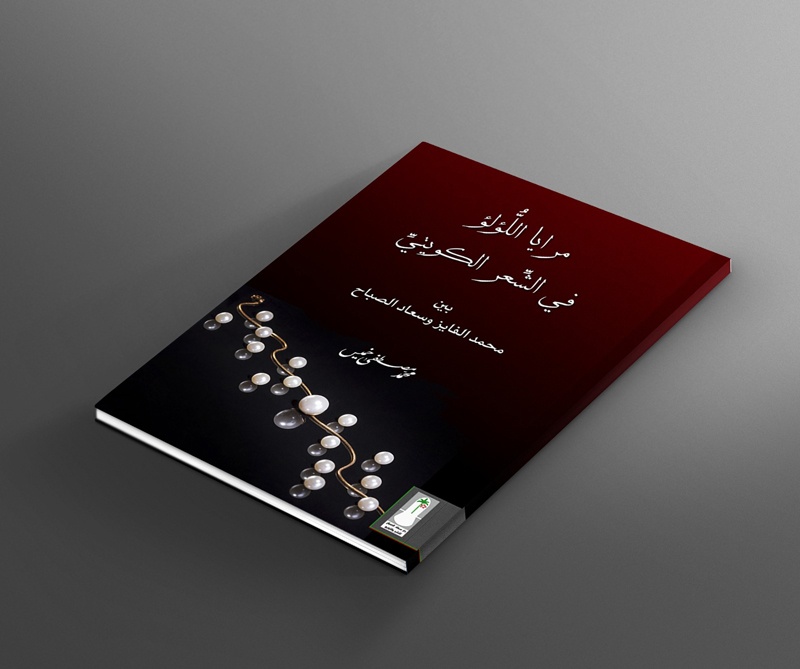 KUWAIT: The cover of 'The Pearl Mirrors' book by author Mohammad Mustafa Khamees.
KUWAIT: The cover of 'The Pearl Mirrors' book by author Mohammad Mustafa Khamees.By Abdellatif Sharaa
KUWAIT: 'The Pearl Mirrors' book joins many other publications, though with a different taste, in analyzing the poetry experience of Dr Suad Al-Sabah. The book - titled 'The Pearl Mirrors in Kuwait's Poetry between Mohammad Al-Fayez and Suad Al-Sabah' - that was issued by Dar Suad Al-Sabah for Publishing and Distribution recently, uses a different tone of critique as it adopts the method of studying phenomena that was represented by the word 'pearl' in Suad Al-Sabah's and Mohammad Al-Fayez's poetry, through tracing the relationship between the signifier and the significance in a way that surpasses unilateralism especially when it is built in various contexts and heterogeneous formats.
The book's author Mohammad Mustafa Khamees starts with the introduction of the word 'pearl' and how it is used by two pioneers of Kuwait poetry: Mohammad Al-Fayez and Suad Al-Sabah, especially in terms of the symbolism it carries as something more valuable than the main goal of the ancestors' historical pearl diving journeys. Khamees explains in the introduction of his book his adoption of integration as a method for his study in order to benefit from many approaches such as the structural, psychological and social methods as well as the reception theory as a reference.
After giving general glimpses about the linguistic and poetic symbolisms for the word 'pearl', he designates the first chapter of the book for the induction of 'The Pearl Mirrors in the Poetry of Mohammad Al-Fayez'. He points to what he describes as the 'pearl complex' as reflected in Fayez's 'A Sailor's Memoirs' poem, as it becomes clear the pearl represented a source of hardship more than a source of happiness and income. The term 'pearl' in this poem became synonymous to poverty and its repercussions, and it was also linked to the impoverished classes whose efforts are lost in achieving the rich class's happiness.
The author highlights the symptoms of what he describes as the 'pearl complex', showcased through the continuous struggle between its ownership and its loss, and represents it as a subjective equivalent of the peak for man while it represents the equivalent of beauty and femininity for woman. Furthermore, it represents the sacrifice for the luxury of beauties, and the class disparity between a merchant and a diver. Then the pearl is portrayed as an equivalent of the full moon that carries the message of change and the sentimental paradox between the images of pearl and sand.
Meanwhile, the author in the second chapter which he built around the images of pearl mirrors in Suad Al-Sabah poetry, stresses that Suad Al-Sabah presents the pearl image in clarity that is not found in other Kuwaiti poems' works, because it represents the main reason for the beauty of that era, including the sacrifices of the family and loved one, as well as elevating the woman's value and the instilment of the noble traditions and the rosy dreams of men.
The author explains the pearl's features in Suad Al-Sabah's 'the Era of Pearls' poem through its interconnection with the text ingredients in the indicative structure in a way that pays attention to the context of address and conditions of its production. The text shows that the poet sees pearls as and equivalent of the beautiful and the past dream era, compared with oil as an equivalent of the fake current era. The poem portrays oil as a force that blinds people to the point where they see its blackness shining brighter and more beautifully than pearls.
The author in his analysis reaches the conclusion that the poet yearns to the beautiful past, and that is why she expresses utter longing to it, and sadness for leaving it behind, and that her clinging to the image of pearls is a form of expressing that longing and sadness. The pearl in her texts does not stop at its literal indication which means the expensive jewels that the ancestors used to extract from the heart of oysters, rather it is the beautiful past, the past of our ancestors and values.










